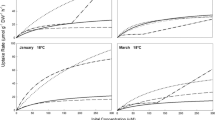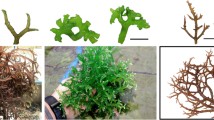Abstract
The effects of hydraulic retention time (HRT) on the performance of algal-bacterial-based aquaponics (AA) were investigated in this study. Both the highest fish growth and algal biomass increase were observed in the AA system at 2-day HRT, resulting in the highest nitrogen utilization efficiency (NUE) (39.28%) in this microcosm. On the contrary, ammonia oxidation bacteria (AOB) abundance at 4-day HRT was approximately ten times higher than that at 2-day HRT, since longer HRT would benefit bacterial growth. The 15N labeling study showed that microalgae assimilation was the main pathway of NH4+ removal in the AA system, and oxygen produced by microalgae could in situ support complete nitrification, thus leading to much lower NH4+ concentrations at 2-day HRT. Accordingly, better water quality was achieved at 2-day HRT. Considering all the factors, HRT of 2-day was considered to be optimal for the AA system.





Similar content being viewed by others
References
Anbalagan A, Schwede S, Lindberg CF, Nehrenheim E (2016) Influence of hydraulic retention time on indigenous microalgae and activated sludge process. Water Res 91:277–284
APHA (2005) Standard methods for the examination of water and wastewater, 21th edn. APHA, Washington, DC
Bovendeur J (1989) Fixed-biofilm reactors applied to waste water treatment and aquacultural water recirculating systems. WUA Dissertation 1317, 171
Cai T, Park SY, Li Y (2013) Nutrient recovery from wastewater streams by microalgae: status and prospects. Renew Sust Energ Rev 19:360–369
Cokro AA, Law Y, Williams RB, Cao Y, Nielsen PH, Wuertz S (2017) Non-denitrifying polyphosphate accumulating organisms obviate requirement for anaerobic condition. Water Res 111:393–403
Dabrowska H, Własow T (1986) Sublethal effect of ammonia on certain biochemical and haematological indicators in common carp (Cyprinus carpio L.). Comp Biochem Physiol C 83(1):179–184
De Antoni MM, Scheer C, Grace P, Rowlings D, Bell M, McGree J (2014) Influence of different nitrogen rates and DMPP nitrification inhibitor on annual N2O emissions from a subtropical wheat–maize cropping system. Agric Ecosyst Environ 186(15):33–43
De Godos I, González C, Becares E, García-Encina PA, Muñoz R (2009) Simultaneous nutrients and carbon removal during pretreated swine slurry degradation in a tubular biofilm photobioreactor. Appl Microbiol Biotechnol 82(1):187–194
Di Termini I, Prassone A, Cattaneo C, Rovatti M (2011) On the nitrogen and phosphorus removal in algal photobioreactors. Ecol Eng 37(6):976–980
Diem TNT, Konnerup D, Brix H (2017) Effects of recirculation rates on water quality and Oreochromis niloticus growth in aquaponic systems. Aquac Eng 78(Part B):95–104
Endut A, Jusoh A, Ali N, Wan Nik WNS, Hassan A (2009) Effect of flow rate on water quality parameters and plant growth of water spinach (Ipomoea aquatica) in an aquaponic recirculating system. Desalin Water Treat 5(1–3):19–28
Endut A, Jusoh A, Ali N, Nik WW, Hassan A (2010) A study on the optimal hydraulic loading rate and plant ratios in recirculation aquaponic system. Bioresour Technol 101(5):1511–1517
Fang Y, Hu Z, Zou Y, Zhang J, Zhu Z, Zhang J, Nie L (2017a) Improving nitrogen utilization efficiency of aquaponics by introducing algal-bacterial consortia. Bioresour Technol 245(Part A):358–364
Fang Y, Hu Z, Zou Y, Fan J, Wang Q, Zhu Z (2017b) Increasing economic and environmental benefits of media-based aquaponics through optimizing aeration pattern. J Clean Prod 162:1111–1117
González C, Marciniak J, Villaverde S, Leon C, Garcia PA, Munoz R (2008) Efficient nutrient removal from swine manure in a tubular biofilm photo-bioreactor using algae-bacteria consortia. Water Sci Technol 58(1):95–102
Hargreaves JA (1998) Nitrogen biogeochemistry of aquaculture ponds. Aquaculture 166(3):181–212
He Q, Zhu Y, Li G, Fan L, Ai H, Huangfu X, Li H (2017) Impact of dissolved oxygen on the production of nitrous oxide in biological aerated filters. Front Environ Sci Eng 11(6):16
Hu Z, Lee JW, Chandran K, Kim S, Khanal SK (2012) Nitrous oxide (N2O) emission from aquaculture: a review. Environ Sci Technol 46:6470–6480
Hu Z, Lee JW, Chandran K, Kim S, Sharma K, Khanal SK (2014) Influence of carbohydrate addition on nitrogen transformations and greenhouse gas emissions of intensive aquaculture system. Sci Total Environ 470:193–200
Hu Z, Lee JW, Chandran K, Kim S, Brotto AC, Khanal SK (2015) Effect of plant species on nitrogen recovery in aquaponics. Bioresour Technol 188:92–98
Kampschreur MJ, Temmink H, Kleerebezem R, Jetten MS, van Loosdrecht MC (2009) Nitrous oxide emission during wastewater treatment. Water Res 43(17):4093–4103
Karya NGAI, Van der Steen NP, Lens PNL (2013) Photo-oxygenation to support nitrification in an algal–bacterial consortium treating artificial wastewater. Bioresour Technol 134:244–250
Kizhedath A, Suneetha V (2011) Estimation of chlorophyll content in common household medicinal leaves and their utilization to avail health benefits of chlorophyll. J Pharm Pharmacol 4(5):1412–1413
Kong AY, Hristova K, Scow KM, Six J (2010) Impacts of different N management regimes on nitrifier and denitrifier communities and N cycling in soil microenvironments. Soil Biol Biochem 42(9):1523–1533
Lee CS, Lee SA, Ko SR, Oh HM, Ahn CY (2015) Effects of photoperiod on nutrient removal, biomass production, and algal-bacterial population dynamics in lab-scale photobioreactors treating municipal wastewater. Water Res 68:680–691
Love DC, Fry JP, Li X, Hill ES, Genello L, Semmens K, Thompson RE (2015) Commercial aquaponics production and profitability: findings from an international survey. Aquaculture 435:67–74
Makhdom S, Shekarabi SPH, Mehrgan MS (2017) Biological nutrient recovery from culturing of pearl gourami (Trichogaster leerii) by cherry tomato (Solanum lycopersicum) in aquaponic system. Environ Sci Pollut Res 24(25):20634–20640
Mujtaba G, Lee K (2017) Treatment of real wastewater using co-culture of immobilized Chlorella vulgaris and suspended activated sludge. Water Res 120:174–184
Muñoz R, Guieysse B (2006) Algal-bacterial processes for the treatment of hazardous contaminants: a review. Water Res 40:2799–2815
Osada T, Shiraishi M, Hasegawa T, Kawahara H (2017) Methane, nitrous oxide and ammonia generation in full-scale swine wastewater purification facilities. Front Environ Sci Eng 11(3):10–17
Ostrand KG, Wilde GR (2001) Temperature, dissolved oxygen, and salinity tolerances of five prairie stream fishes and their role in explaining fish assemblage patterns. Trans Am Fish Soc 130(5):742–749
Pinho SM, Molinari D, de Mello GL, Fitzsimmons KM, Emerenciano MGC (2017) Effluent from a biofloc technology (BFT) tilapia culture on the aquaponics production of different lettuce varieties. Ecol Eng 103:146–153
Shi Y, Huang C, Rocha KC, El-Din MG, Liu Y (2015) Treatment of oil sands process-affected water using moving bed biofilm reactors: with and without ozone pretreatment. Bioresour Technol 192:219–227
Silva CR, Gomes LC, Brandão FR (2007) Effect of feeding rate and frequency on tambaqui (Colossoma macropomum) growth, production and feeding costs during the first growth phase in cages. Aquaculture 264(1):135–139
Sukačová K, Trtílek M, Rataj T (2015) Phosphorus removal using a microalgal biofilm in a new biofilm photobioreactor for tertiary wastewater treatment. Water Res 71:55–63
Tang CC, Zuo W, Tian Y, Sun N, Wang ZW, Zhang J (2016) Effect of aeration rate on performance and stability of algal-bacterial symbiosis system to treat domestic wastewater in sequencing batch reactors. Bioresour Technol 222:156–164
Tokunaga K, Tamaru C, Ako H, Leung P (2015) Economics of small-scale commercial aquaponics in Hawai’i. J World Aquacult Soc 46(1):20–32
Tyson RV, Treadwell DD, Simonne EH (2011) Opportunities and challenges to sustainability in aquaponic systems. Horttechnology 21:6–13
Wang L, Min M, Li Y, Chen P, Chen Y, Liu Y, Wang Y, Ruan R (2010) Cultivation of green algae Chlorella sp. in different wastewaters from municipal wastewater treatment plant. Appl Biochem Biotech 162(4):1174–1186
Wang M, Yang H, Ergas SJ, van der Steen P (2015) A novel shortcut nitrogen removal process using an algal-bacterial consortium in a photo-sequencing batch reactor (PSBR). Water Res 87:38–48
Wongkiew S, Hu Z, Chandran K, Lee JW, Khanal SK (2017) Nitrogen transformations in aquaponic systems: a review. Aquac Eng 76:9–19
Zhi W, Ji G (2014) Quantitative response relationships between nitrogen transformation rates and nitrogen functional genes in a tidal flow constructed wetland under C/N ratio constraints. Water Res 64:32–41
Zou Y, Hu Z, Zhang J, Xie H, Guimbaud C, Fang Y (2016a) Effects of pH on nitrogen transformations in media-based aquaponics. Bioresour Technol 210:81–87
Zou Y, Hu Z, Zhang J, Xie H, Liang S, Wang J, Yan R (2016b) Attempts to improve nitrogen utilization efficiency of aquaponics through nitrifies addition and filler gradation. Environ Sci Pollut Res 23(7):6671–6679
Acknowledgements
This study was supported by the National Natural Science Foundation of China (51878388), Shandong Provincial Key Research and Development Plan (No. 2017GSF216011), Fundamental Research Funds of Shandong University (No. 2017JC025), and Natural Science Foundation of Shandong Province (No. ZR2018QEE006).
Author information
Authors and Affiliations
Corresponding author
Ethics declarations
Conflict of interest
The authors declare that they have no conflict of interest.
Ethical approval
This article does not contain any studies with human participants performed by any of the authors.
This article used fish (Cyprinus carpio) as an experimental object. All applicable international, national, and/or institutional guidelines for the care and use of animals were followed.
Electronic supplementary material
ESM 1
(PDF 74 kb)
Rights and permissions
About this article
Cite this article
Fang, Y., Chen, X., Hu, Z. et al. Effects of hydraulic retention time on the performance of algal-bacterial-based aquaponics (AA): focusing on nitrogen and oxygen distribution. Appl Microbiol Biotechnol 102, 9843–9855 (2018). https://doi.org/10.1007/s00253-018-9338-1
Received:
Revised:
Accepted:
Published:
Issue Date:
DOI: https://doi.org/10.1007/s00253-018-9338-1




